4.4 NUTRIENT FILM TECHNIQUE (NFT)
The NFT is a hydroponic method using horizontal pipes each with a shallow stream of nutrient-rich aquaponic water flowing through it (Figure 4.60). Plants are placed within holes in the top of the pipes, and are able to use this thin film of nutrient-rich water.
FIGURE 4.60
Illustration of a small nutrient film technique unit
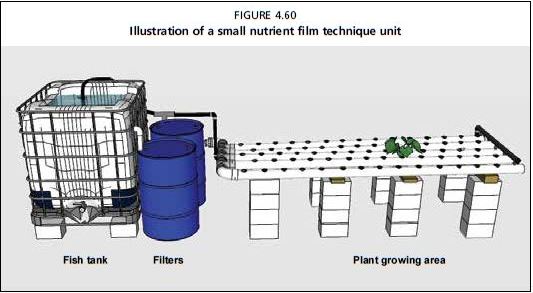
FIGURE 4.61 Lettuce growing in a commercial nutrient film technique unit
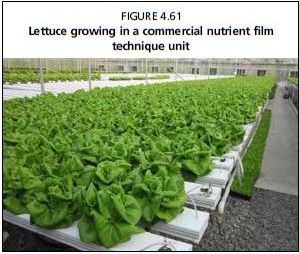
Both the NFT and DWC are popular methods for commercial operations as both are financially more viable than media bed units when scaled. up (Figure 4.61). This technique has very low evaporation because the water is completely shielded from the sun. This technique is far more complicated and expensive than media beds, and may not be appropriate in locations with inadequate access to suppliers. This technique is most useful in urban applications, especially when using vertical space or weight-limitations are considerations.
Although all methods have a different approach to actually growing plants, the most important difference between them is the method
of filtration that both the NFT and DWC units utilize compared with the media bed method. The following text describes this method of filtration for NFT and DWC units in detail. Afterwards, the NFT and DWC methods are discussed individually. The general layout of this section begins with water flow dynamics, or how the water moves through the system. Then filtration methods are discussed, followed by specific planting guidelines for NFT systems.
4.4.1 Water flow dynamics
The water flows by gravity from the fish tank, through the mechanical filter and into the combination biofilter/sump. From the sump, the water is pumped in two directions through a "Y" connector and valves. Some water is pumped directly back to the fish tank. The remaining water is pumped into a manifold that distributes the water equally through the NFT pipes. The water flows, again by gravity, down through the grow pipes where the plants are located. On exiting the grow pipes, the water is returned to the biofilter/sump, where again it is pumped either into the fish tank or grow pipes. The water that enters the fish tank causes the fish tank to overflow through the exit pipe and back into mechanical filter, thus completing the cycle.
This design, as described in this publication, is called a "Figure 8" design because of the path of the water. This design ensures that filtered water enters both the fish tank and the grow pipes, while only using one pump. There is no need to place the sump lower than the rest of the unit, making this design possible to use on existing concrete floors or on rooftops. All components are at a comfortable working level for the farmer without stooping or using ladders. Moreover, the design fully utilizes the size of the IBC container to ensure adequate room for the fish. One drawback is that the combination sump/biofilter works to dilute the nutrient concentration of the water reaching the grow pipes, and at the same time, returns water to the fish before the water has been fully stripped of nutrients. However, the slight dilution is managed by controlling the bidirectional flow leaving the sump/biofilter and, overall, it has little effect on the efficacy of this system in light of the benefits provided. Generally, the pump returns 80 percent of the water to the fish tanks and the remaining 20 percent to the grow beds or canals, and this can be controlled with the valve.
4.4.2 Mechanical and biological filtration
Dedicated filtration is of critical importance in both NFT and DWC units. Whereas the medium in the media bed technique serves as a biofilter and a mechanical filter, the NFT and DWC techniques do not have this luxury. Therefore, both types of filters need to be deliberately constructed: first, a physical trap to catch the solid wastes, and then a biological filter for nitrification. As mentioned in Section 4.3, there are many types of mechanical filters, and NFT and DWC units require those at the high end of the spectrum outlined therein. The designs described in Appendix 8 use a mechanical swirl filter to trap particulate wastes, with periodic venting of the captured solids. On exiting the swirl filter, the water passes through an additional mesh screen to trap any remaining solids and then reaches the biofilter. The biofilter is well oxygenated with air stones and contains a biofiltration media, usually Bioballs, nylon netting or bottle caps, where the nitrifying bacteria transform the dissolved wastes. With insufficient filtration, both NFT and DWC units would clog, become anoxic and exhibit poor growing conditions for plants and fish alike.
4.4.3 Nutrient film technique grow pipes, construction and planting
Following on from the filtration methods explained above, NFT then employs the use of plastic pipes laid out horizontally to grow vegetables using the aquaponic water (Figure 4.62). Where possible, use pipes of rectangular section with width larger than height, which is standard among hydroponic growers. The reason lies in a larger film of water that hits the roots with the scope of increasing the nutrient uptake and plant growth. One of the benefits of the NFT is that the pipes can be arranged in many patterns, beyond the scope of this publication, and can make use of vertical space, walls and fences, and overhanging balconies (Figure 4.63).
FIGURE 4.62
Lettuce growing in square grow pipes of a nutrient film technique unit
FIGURE 4.63
Grow pipes of a nutrient film technique unit arranged vertically
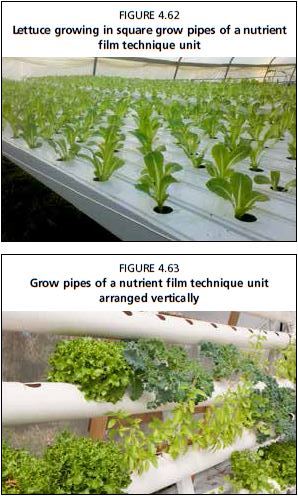
The water is pumped from the biofilter into each hydroponic pipe with a small equal flow creating a shallow stream of nutrient-rich aquaponic water flowing along the bottom. The grow pipes contain a number of holes along the top of the pipe into which the plants are placed. As the plants start to consume the nutrient-rich water from the stream, they begin to develop root systems inside the grow pipes. At the same time, their stems and leaves grow out and around the pipes. The shallow film of water at the bottom of each pipe ensures that the roots receive large amounts of oxygen at the root zone along with moisture and nutrition. Keeping a
shallow stream allows the roots to have a larger air exchange surface. The water flow for each grow pipe should be no greater than 1-2 litres/min. The flow rate is controlled from the Y-valve, with all excess water flow returned to the fish tank.
Grow pipe shape and size
It is wise to choose a pipe with the optimum diameter for the types of plants grown. Pipes with a square cross-section are best, but round pipes are more common and totally acceptable. For larger fruiting vegetables, 11 cm diameter grow pipes are needed. while fast-growing leafy green and small vegetables with small root masses only require pipes with a diameter of 7.5 cm. For small-scale polyculture (growing many types of vegetables) 11 cm diameter pipes should be used (Figure 4.64). This avoids plant selection limitations because the small plants can always be grown in the larger pipes, although there would be a sacrifice in planting density. Plants with extensive root
FIGURE 4.64 Several grow pipes showing hole spacing
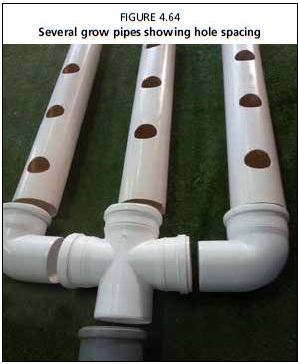
systems, including mature older plants, can clog smaller pipes and cause overflows and losses of water. Be especially mindful of tomatoes and mint, as their massive root systems can easily clog even large pipes.
The grow pipe length can be anywhere between 1 and 12 m. In pipes longer than 12 m, nutrient deficiencies can occur in plants towards the end of the pipes because the first plants have already stripped the nutrients. A slope of about 1 cm/m of pipe length is needed to make sure the water flows through the whole pipe with ease. The slope is controlled by using shims (wedges) on the side away from the fish tank.
PVC pipes are recommended because they are usually the most commonly available and are inexpensive. White pipes should be used as the colour reflects the sun's rays, thereby keeping the inside of the pipes cool. Alternatively, square or rectangular hydroponic pipes with dimensions 10 cm width x 7 cm height are recommended. Professional hydroponic pipes for commercial growers are typically this shape, and some growers use vinyl fence posts.
Planting within the grow pipes
The holes drilled into the hydroponic pipe should be 7-9 cm in diameter, and should match the size of the available net cups. There should be a minimum of 21 cm between the centre of each plant hole to allow adequate plant space for leafy greens and larger vegetables (Figures 4.65 and 4.66).
Each seedling is placed into a plastic net cup, which is then in turn placed within the grow pipe. This provides physical support for the plant. The net cups are filled with general purpose hydroponic media (volcanic gravel, rockwool or LECA) around the seedling. If desired, a 5-10 cm length of 5 cm PVC pipe can be placed inside the net cup as further balance and support to the plant. Detailed planting instructions are included in Appendix 8.
If plastic net cups are not available or are too costly, it is possible to use regular plastic drinking cups. Follow the planting procedure as outlined in the previous paragraph making sure to add many holes to the plastic drink cup so the roots have
FIGURE 4.65
Plant support materials showing grow medium and net cup
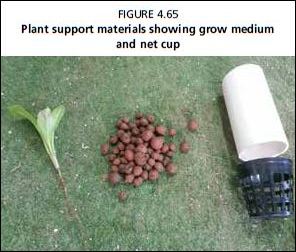
plenty of access into the grow pipe. Other growers have had success with flexible, open-cell foam to support the plants within the grow pipe. If none of these options is available or desired, it is possible to transplant the seedlings directly into the pipes, particularly rectangular pipes (Figure 4.67). Seedlings can be transplanted with their germination medium, which will wash away into the system or the roots can be carefully rinsed, which keeps medium out of the system but can increase the transplant stress. Nevertheless, it is preferable to use net cups filled with media.
When initially planting the seedlings into the pipe, make sure the roots can touch the stream
FIGURE 4.66
Full size lettuce harvested from a nutrient film technique unit. Net cup and PVC extender are dearly visible
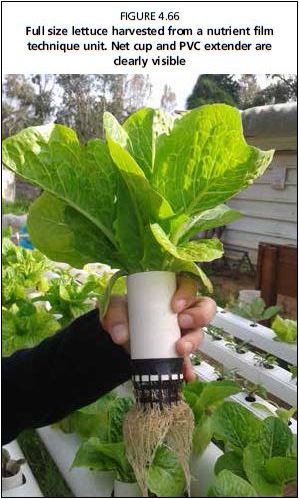
FIGURE 4.67
Lettuce plant grown without a net cup directly in a grow pipe
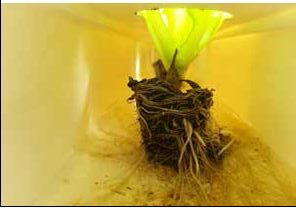
of water at the bottom of the pipe. This will ensure that the young seedlings do not become dehydrated. Alternatively, wicks can be added that trail into the water stream. In addition, it is advisable to water the seedlings with aquaponic water one week prior to transplanting them to the unit. This will help mitigate against transplant shock for the plants as they become accustomed to the new water.